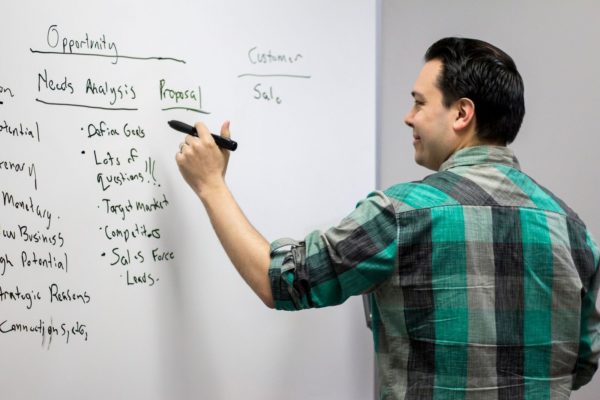Joe works at Artonic, a Michigan Web Design Agency.
-
What types of tasks do you tackle every week at Artonic?
Artonic is oriented towards achieving our clients’ sales and marketing goals, which means that we leverage a wide-range of methods and tasks to achieve those goals. I typically handle technical project management, support, and consultative sales (sort of a “sales engineer”), but I’ve got my hands in several areas: technical, creative, strategic, relational. There are pros and cons to wearing multiple hats, but it does provide a big-picture perspective on how everything works together for larger initiatives.
-
What do you enjoy most about your job?
I enjoy the sheer variety of projects, but more than that, there’s gratification in making a quantifiable business impact for our clients.

-
How would you describe what you do to someone who doesn’t work with you?
I help growth-oriented businesses generate more web traffic, leads, and sales! As a Project Strategist at Artonic, I synthesize marketing, sales, design, usability, and technical know-how to help businesses see the big picture and create a game plan for success. In short, you need a project to generate ROI, we’ll flesh out how to move the needle.
-
How would you describe Artonic’s team?
Professional, hard-working, and easy to work with. Artonic has a great team – and that makes all the difference in the world!
-
What advice do you have for companies who want more online sales?
There usually isn’t a silver bullet when it comes to generating online sales. You need a clear picture of your customer, your core value proposition, and a strategy for communicating this proposition to your ideal customer. This will allow to find the right combination of tactics to generate sales. Also, don’t expect instant results.
Too many people pull the plug on something that’s working because they have the wrong expectations (maybe they don’t understand their sales cycle, etc.).
-
How would you explain user experience to someone who’s never heard of it before?
The amount of time you’re sitting in the drive through of your favorite fast-food restaurant is user experience. The number of phone options you wade through to speak with a real person from customer support is user experience. The temperature and humidity of your hotel room is user experience. User experience describes what a person thinks, feels, understands, and experiences as they use your product or service. In the online realm, this translates to how long it takes for your website to load, how easy it is for someone to find what they’re looking for in your e-commerce store, whether your website is browsable on a mobile device. User experience is a big deal, because it takes just a little bit of frustration or confusion on the part of the user to kill a sale. But a delightful user experience can result in exponential success.
-
What’s the most important part of a website build?
There isn’t really an “unimportant” phase on the website build. However, if you don’t get the planning phase right, it’s very difficult to see success in the latter phases. Why? Because it’s critical to know the website’s purpose and goals prior to embarking on what could be a time and cost-intensive project. Know what you’re trying to accomplish, and consider both the short and long term.
To be sure, there may be a lot of unknowns for large, complex websites, and it may be difficult to define everything up front. In those cases, we’ve had success tackling the website project as a series of “mini projects.” This includes launching a “minimum viable product” (MVP), then adding features in waves. All too often, businesses have difficulty articulating the “why” of their website (let alone the “how”), and end up wasting resources.

-
What do you think most impacts the success of a website?
The organization that owns the website.
In the “The Advantage: Why Organizational Health Trumps Everything Else In Business,” Patrick Lencioni, says: “The health of an organization provides the context for strategy, finance, marketing, technology, and everything else that happens within it, which is why it is the single greatest factor determining an organization’s success. More than talent. More than knowledge. More than innovation.” (pg. 3).
-
What types of website functionality can Artonic handle that you can’t get out of a DIY template solution?
At Artonic we’ll build a website around an organization and its goals, rather than trying to force an organization into a specific mold. Oftentimes, this translates to building a custom website, utilizing a more direct approach to achieving special functionality, and creating a lightweight, tailored solution.
That said, there are advantages and disadvantages to both sides of the template versus “custom website” argument. All kinds of things are possible with a custom website. But in all fairness, the possibilities need to be tempered by comparing cost versus benefit. On the one hand, a template can provide a quick, inexpensive start, especially if the product or service you offer is a commodity. On the other hand, a template-based website can be problematic when you’ve got a unique business model, need to scale, or need integrate with a third-party software (e.g., a CRM). You also need to consider the total cost of ownership, not just the initial cost of getting a website off the ground.
As a side note, WordPress enters the conversation at some point. As the most popular platform in the world, with many ready-made plugins and themes to choose from, WordPress is usually the go-to for a DIY template solution. We build and maintain WordPress websites. For many situations, it’s a great fit. However, in the wrong hands, I’ve seen WordPress turn into an unwieldy, bloated “Frankenstein” very quickly. Furthermore, because of its popularity as a content management system (CMS), it’s a frequent target for hackers. So it’s important to take an expert development approach to WordPress and couple it with a solid hosting environment.
Ultimately, there are times when going DIY makes sense. But keep in mind that there’s also a time to heed the saying, “If you think it’s expensive to hire a professional, try hiring an amateur.”
-
Why would a business owner or company benefit from a Support Plan?
Think of a website as an employee, a living, breathing entity. It’s not set in stone. As such, it can (and should) adjust to changes in its environment. A Support Plan essentially covers updates and changes after you launch your website. Sometimes a business doesn’t have the internal staff to maintain its website; other times, a business’ IT or marketing personnel needs to focus their time and expertise on other initiatives. A Support Plan allows a business to maximize its website’s effectiveness by keeping it up to date, adjusting areas that require improvement, and addressing urgent problems. Artonic’s Support services are second-to-none in terms of responsiveness and worry-free execution. We can usually get things done faster than an internal employee. In fact, we have clients who didn’t build their website through Artonic, but utilize our support services.
Contact Joe with questions about your online presence at [email protected].



